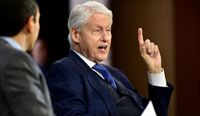Former President Bill Clinton, now 79, has reignited public concern over his health after being photographed in the Hamptons with a portable defibrillator in tow. The sighting, which occurred on Thursday, August 28, 2025, as he and his wife, former Secretary of State Hillary Clinton, boarded a private plane, has prompted renewed scrutiny of the former president’s long struggle with cardiac issues and overall well-being.
According to Daily Mail, the device seen with the Clintons was a Propaq MD Air Medical Bag, a lightweight transport monitor and defibrillator commonly used for emergency heart monitoring and intervention. The couple, both dressed for travel and accompanied by security, appeared calm, but the presence of the medical equipment was hard to miss—and even harder to ignore given Bill Clinton’s well-documented health history.
Clinton’s heart troubles are not new. As RadarOnline.com and Cedar News reported, his first major scare came in 2004, just a few years after leaving the White House. Doctors discovered that several of his arteries were nearly 100 percent blocked, prompting an emergency quadruple bypass surgery at the Vivian and Seymour Milstein Family Heart Center of Presbyterian Hospital in Manhattan. At the time, physicians said he had narrowly avoided a catastrophic heart attack.
That procedure was followed by further complications. In 2010, after experiencing chest discomfort, Clinton underwent a stent placement—another common but significant intervention for someone with his history. He’s also had surgery for a collapsed lung, according to Cedar News. In an effort to improve his prognosis, Clinton adopted a vegan diet and has publicly credited the lifestyle change with giving him "a second chance at life." Yet, despite these efforts, the health scares have not stopped coming.
More recently, in 2021, Clinton was hospitalized for a urological infection that developed into sepsis, a dangerous bloodstream infection. Then, just last year, he spent Christmas Eve at MedStar Georgetown University Hospital in Washington, D.C., after developing a fever and being treated for the flu. Angel Urena, his former deputy chief of staff, released a statement at the time, saying, "President Clinton was discharged earlier today after being treated for the flu. He and his family are deeply grateful for the exceptional care provided by the team at MedStar Georgetown University Hospital and are touched by the kind messages and well wishes he received. He sends his warmest wishes for a happy and healthy holiday season to all." Urena had noted the day before that Clinton was in "good spirits" and hoped to spend Christmas at home, as reported by Daily Mail and RadarOnline.com.
Despite these episodes—and a recent stumble on a New York City sidewalk that was widely reported—Clinton has remained active in public life. He continues to participate in Clinton Foundation events, make public appearances, and, as AINVEST highlighted, maintain a visible role in the political and philanthropic spheres. Still, the sighting of a portable defibrillator has sparked intense speculation about the progression of his heart condition. Such devices are typically reserved for patients at high risk of cardiac arrest, underscoring the seriousness of his ongoing health management.
Clinton’s health challenges have also become part of a broader conversation about aging political leaders. As he approaches his 80th birthday, his situation mirrors those of other senior statespersons whose health is closely monitored by the public and media alike. The pressures and demands of life after the presidency, coupled with a history of complex medical issues, make Clinton’s case particularly compelling—and, some would say, cautionary.
Meanwhile, the Clintons have found themselves back in the political spotlight for reasons beyond health. On August 5, 2025, both Bill and Hillary were subpoenaed by the House Oversight Committee as part of a congressional investigation into the government’s handling of the Jeffrey Epstein case. Neither is currently under investigation, but their depositions are expected to explore connections between the disgraced financier and prominent public figures, including themselves. Hillary is scheduled to testify on October 9, with Bill set for October 14. Whether they will comply with the subpoenas remains to be seen, but the episode has added another layer of scrutiny to their already high-profile lives.
In his 2024 memoir, Clinton addressed his controversial association with Epstein, admitting to flying on the financier’s private jet but maintaining he had no knowledge of Epstein’s criminal activities. "The bottom line is, even though it allowed me to visit the work of my foundation, traveling on Epstein’s plane was not worth the years of questioning afterward. I wish I had never met him," Clinton wrote, as cited by RadarOnline.com and Daily Mail. The admission, while candid, did little to quell public curiosity or speculation about the nature of their relationship.
Despite the relentless attention—be it for his health or his past associations—Clinton has continued to put on a brave face. He and Hillary remain politically engaged, even as the pace of their public engagements has slowed. The former president’s resilience is notable, but his visible frailty and reliance on advanced medical equipment serve as a stark reminder of the toll that both time and the presidency can take on an individual.
Speculation about Clinton’s condition has been fueled by the recent defibrillator sighting, but his doctors have not publicly commented on any new diagnosis. Rumors about possible Parkinson’s disease have circulated, especially after his stumble in New York, but no official confirmation has been made. As Cedar News emphasized, Clinton’s medical team has only acknowledged his prior cardiac and infection-related treatments.
For many Americans, Clinton’s ongoing health journey is emblematic of the broader challenges faced by aging leaders in the public eye. It raises questions about the capacity and resilience required to serve at the highest levels of government—and about the medical vigilance necessary for those who have spent decades in high-stress roles. Clinton’s story, marked by repeated health scares, lifestyle changes, and continued public engagement, offers a window into both the vulnerabilities and strengths of those who have shaped recent American history.
As the former president prepares for another round of political scrutiny this fall, the public will no doubt continue to watch his health—and his every move—with a mixture of concern, curiosity, and respect for a figure who, despite everything, remains a fixture in American life.


